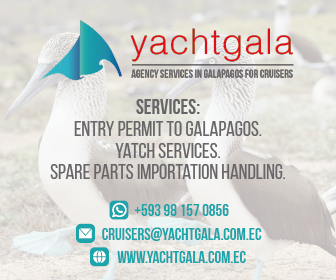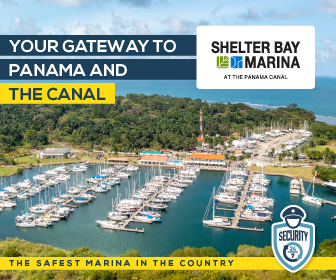Panama/Ecuador to Chile
Published 8 years ago, updated 6 years ago
I am writing this to offer an alternative approach to Chile from Panama and/or Ecuador.
I’m sure that many others have taken this route, but most accounts I’ve read have people either motoring the coast of Peru from Salinas or sailing out to the Galapagos and then down, to Easter Island, perhaps, then in again to Valdivia or Puerto Montt.
Having already cruised the Galapagos, as well as exploring the coast and interior of Peru, and not wanting to be subject to the outrageous bureaucracy and expense of check-ins at Peruvian ports, nor wanting to deal with the constant onslaught of the Humboldt Current nor play dodgeball at night with the hordes of fishing boats that ply the coast of Peru (impossible to sleep as I was single-handing), I opted instead to sail offshore, staying 400-600nm off of the coast of Peru with a series of long tacks–the first one being 6 days long, with several subsequent tacks of 2-3 days. My last tack, pretty much straight east into Iquique, was 7 days.
My original intention was to sail directly from Panama to Chile, offshore, but the boat needed some minor repairs (and I wanted to surf one of my favourite breaks in Ecuador), so I detoured to Ecuador for 10 days before setting off for Chile.
The dates of my trip are as follows, the last 2 being the 30-day, non-stop passage to Chile:
Dec. 24, 2016: Departed La Playita, Panama
Dec. 29, 2016: Arrived Mompiche, Ecuador
Jan. 02, 2017: Departed Mompiche, Ecuador
Jan. 04, 2017: Arrived Isla de la Plata, Ecuador
Jan. 05, 2017: Departed Isla de la Plata, Ecuador
Jan. 06, 2017: Arrived Salinas, Ecuador
Jan 08, 2017: Departed Salinas, Ecuador
Feb 06, 2017: Arrived Iquique, Chile
Passage Ecuador to Chile
The first week or so was fairly brisk sailing; squalls were numerous but none packed much punch in terms of wind or rain. After that, being on the edge of the S. Pacific High, it was very light winds (I got great use out of my drifter) and periods of calm, during which I motored. If my SOG dropped to less than 2 knots and stayed there, I motored. However, I sailed much more than I motored, and I was able to enjoy long periods of sleep!
It was a slow passage – 30 days in total from Salinas to Iquique, but it was muy Tranquilo! Winds rarely exceeded 20 knots and I reefed only 3 times. Sure, I would have liked more wind and a faster passage, but for me, it was much better than motor-sailing down the coast.
Iquique
A chose Iquique as a clearance port as it’s a much better option than Arica, in terms of check-in costs and the possibility of leaving the boat their long term.
Before entering, I tried calling both the Club de Yates and the Armada/Capitania de Puerto on VHF, Ch’s 9 & 16, several times, in Spanish, from 20, 10, 5 and 1 mile out, and again as I entered the harbour. I never got a response, so I went in blind. I definitely recommend entering the harbour during daylight hours only, especially if wanting to go directly to the Yacht Club.
There is a fair amount of activity in Iquique Harbor, both fishing boats and larger container ships and freighters. After rounding the 2 large commercial wharves that trend NE from Peninsula Serrano, head south (approx. 203 deg. M) in toward the YC. There is a red lateral buoy to port and further in is Roca Patilliguaje, to starboard, marked by a lighted green buoy. Give plenty of room!
There are several submerged and semi-submerged wrecks and reefs, and, the water in the “channel” is shallow. I came in on high tide (tidal range is minimal) and was recording depths of 8-10 feet, so one should approach slowly and cautiously! The closer in you gets the narrower it becomes as there are many anchored fishing vessels.
Fortunately, as I approached the YC, I noticed a man standing at the end of one of the docks waving me in. It was Patricio, the Club Administrator. He had me back into an empty “slip”; I threw him my stern lines and then I tied the bowline off to a fixed mooring ball ahead.
It was Patricio who called the Capitania for me, to notify them, and the other agencies, of my arrival. As mentioned in my report, they came, en masse, and were sitting in the cockpit of Mar de Luz within an hour of my arrival. I really do think that it helped my cause, and perhaps my pocketbook, that I was able to speak with them and conduct all check-in business in Spanish.
Here is Patricio’s (Club de Yates) contact info:
Patricio Luis Vargas Herrera, Club Administrator
Cell: +56 998875520
Email: purasangre1327@hotmail.com
Check-in at Iquique couldn’t have been easier nor less expensive. I’d read reports of people having to pay $450 or more for agricultural inspection fees, etc. Within an hour of securing my dock lines at the Club de Yates Iquique, I had a representative or 2 from every agency—Customs, Immigration, Port Captain, Armada, Agriculture, etc.—in the cockpit, handing me paperwork to complete. The process went quickly and smoothly and the total cost was $25US!
The docks are not pristine, rough actually, and some of the cleats are loose. The club itself is very secure, though. There is a high wall and locked gate to the street that leads to the commercial wharves in one direction and the city centre in the other direction. Patricio himself is there from 8 am to 5 pm, M-F (and possibly on weekends). There are also day and night watchmen. A bathroom with showers (cold water) is available. I was told that diesel or gas is available by tanker truck with a long hose, or one can walk to a nearby gas station with jerry jugs.
Iquique and the harbour experience very little in the way of high winds or swell wrapping into the harbour, contrary to what I’ve heard about Arica, the latter, anyway. It virtually never rains and temperatures are moderate. There is a huge population of birds, however, mostly Inca Terns–beautiful but noisy and messy. The folks at the YC do their best to shoo them off of boats docked there.
Iquique is a rustic, yet lovely town which serves as a tourist destination for Chileans and Bolivians who want to enjoy the miles of beaches and the many fine restaurants and few casinos there. It is a mix of old, nitrate mine-era buildings and houses and more modern buildings. There is a large central plaza, where local folks and tourists congregate, that is surrounded by restaurants, coffee shops, and bars, etc. All of this, as well as several supermarkets and department stores, is within a short walking distance from the Yacht Club. The bus station is also within walking distance to the Club (approx. 15 min). From there, one can bus north into Arica, or beyond to Peru or Bolivia, or south to Santiago or other destinations in Chile. The airport, Diego Aracena International Airport, is 48km south of Iquique!
I opted to leave my boat, “med-moored” in Iquique, at the Yacht Club, as my initial departure from Panama was delayed a month and I’d run out of time to make it to Puerto Montt. Cost per month is $560US.
I will return next fall to continue making my way down the coast of Chile, and, hopefully into the Canals.
If anyone would like more info., feel free to contact me.
Ron Kucera (USA)
SV Mar de Luz
Related content
Related to the following Cruising Resources: Pacific Ocean East, Routing








